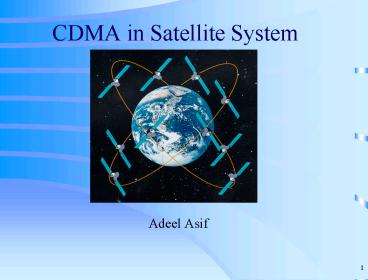CDMA in Satellite System PowerPoint PPT Presentation
1 / 21
Title: CDMA in Satellite System
1
CDMA in Satellite System
- Adeel Asif
2
Outline
- Basic Concepts
- Cellular System
- Frequency reuse
- Hand Off
- Satellite Communications System
- Why Satellite Communications System
- Multiple Access Schemes
- CDMA Core Concepts
- Advantages of CDMA
- Challenges of CDMA
- Conclusion
3
Basic Concepts Cellular System
4
Basic Concepts - Frequency Reuse
7 cell re-use pattern
5
Basic Concepts Hand Off
6
Satellite System
- Traditionally
- weather satellites
- satellites for navigation
- Telecommunication
- Broadcast service over a wide area
- global telephone connections
- connections for communication in remote places or
underdeveloped areas - ? Satellite mobile communication for 3rd
generation systems
7
Why Satellite Communications System ?
- Main Advantages
- Extend capability of existing terrestrial
cellular system - Coverage in remote locations
- Large coverage area
- Seamless service to subscriber in any part of the
world - Challenges
- Propagation delay
- Attenuation
- Low Spectral efficiency
8
Typical satellite systems
Inter Satellite Link (ISL)
Mobile User Link (MUL)
MUL
Gateway Link (GWL)
GWL
small cells (spotbeams)
base station or gateway
footprint
GSM
PSTN
ISDN
User data
PSTN Public Switched Telephone Network
9
Multiple Access Schemes for Satellite
Communications
- A multiple access scheme is expected to provide
users to simultaneously access a satellite
terminal efficiently - In a satellite communications system, designing
a multiple access scheme is one of the most
challenging issues
10
Frequency Division Multiple Access (FDMA) assigns
individual channels (i.e frequencies) to
individual users
Multiple Access Schemes
11
Multiple Access Schemes
- Time Division Multiple Access (TDMA)
- The spectrum is divided into time slots, in each
slot only one user can transmit or receive - TDMA shares a single carrier with several users
12
Multiple Access Schemes
- Code Division Multiple Access (CDMA)
- All the users in this system, use the same
carrier frequency and may transmit simultaneously - Lets take a closer look at it!
13
Multiple Access Schemes
14
CDMA
- Spread Spectrum Systems
- Wireless Communication technique that uses
transmission bandwidth substantially larger than
the signal bandwidth - Many users can simultaneously use the same
bandwidth without significantly interfering with
one another - There are many applications including Global
Positioning System, Wireless LAN e.g. Bluetooth - CDMA
- In CDMA user data is multiplied with a
pseudo-noise (PN) sequence called the spreading
signal - This causes the spectrum to be spread to several
orders of magnitude greater than the minimum
signal bandwidth
15
PN Sequence
- PN sequence is a binary sequence that appears
random but can be reproduced in a deterministic
manner by intended receiver - The rate of the PN code called the chip rate,
must be much higher than the rate of the
information signal
16
How it works !
- The information signal is demodulated at the
receiver by cross-correlation with a locally
generated replica of the users PN sequence. - The signal is de-spread and is restored to the
original signal. - Cross-correlation with PN sequence of other users
results in a very small noise at the receiver.
17
Why CDMA (I) ?
- Exploitation of multipath RAKE Receiver
- Satellite path diversity exploitation for
- Improved quality of service
- Fading effects mitigation
- Immunity from jamming signals, external
interference and multipath distortion - Full frequency reuse easing resource allocation
18
Why CDMA (II) ?
- Soft handoff Improved quality of Service
19
Challenges
- Nonlinearity in satellite communications causes
degradation in performance - Power Control - Near / Far Effect
- Open loop power control
- Closed loop power control
- Synchronization
20
Conclusion
- Satellite Communications is required to extend
the capabilities of cellular systems in 3rd
Generation Systems - CDMA is preferred multiple access scheme because
of its advantages like diversity and multipath
exploitation, soft handoff characteristics - CDMA however, faces challenges like performance
degradation due to nonlinearity in satellite
system and handling of power control and
synchronization
21
Back up slide

